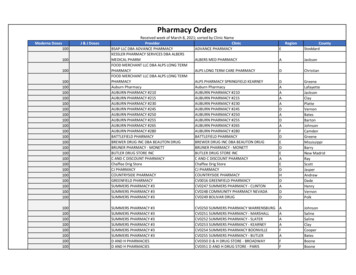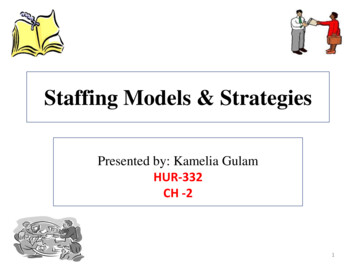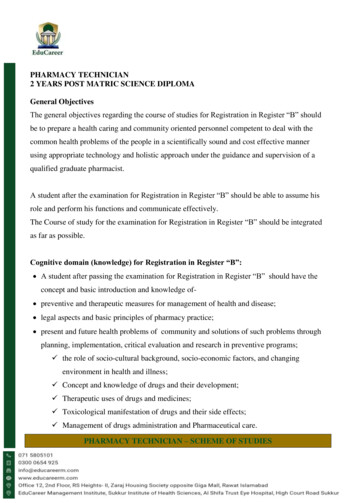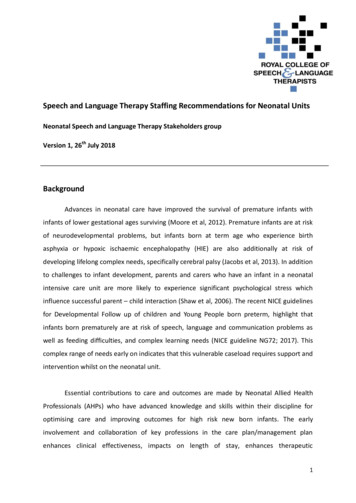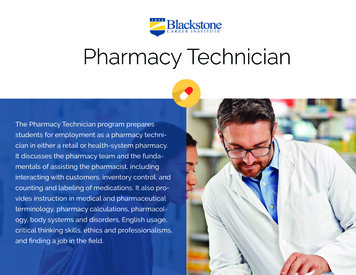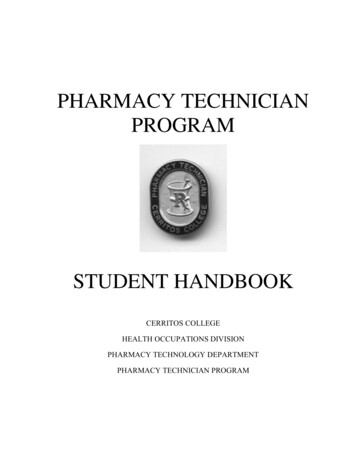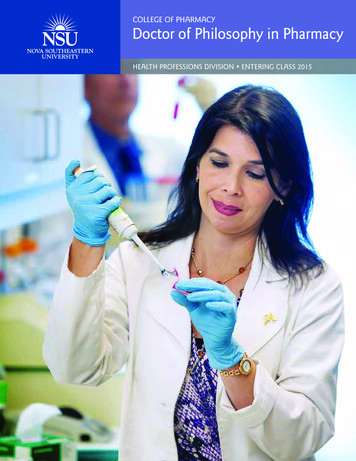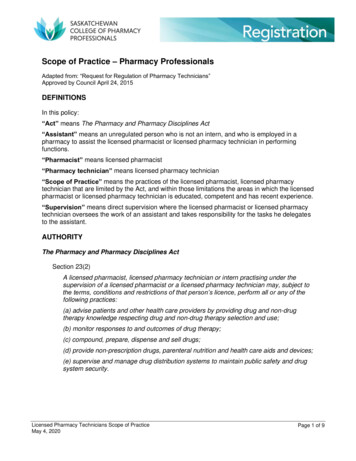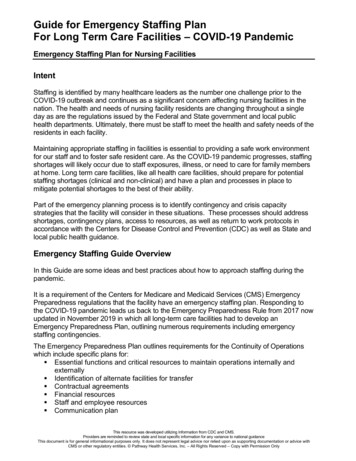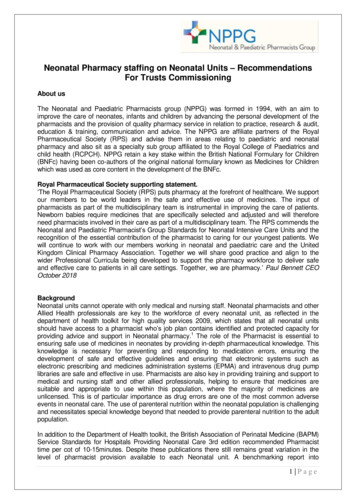
Transcription
Neonatal Pharmacy staffing on Neonatal Units – RecommendationsFor Trusts CommissioningAbout usThe Neonatal and Paediatric Pharmacists group (NPPG) was formed in 1994, with an aim toimprove the care of neonates, infants and children by advancing the personal development of thepharmacists and the provision of quality pharmacy service in relation to practice, research & audit,education & training, communication and advice. The NPPG are affiliate partners of the RoyalPharmaceutical Society (RPS) and advise them in areas relating to paediatric and neonatalpharmacy and also sit as a specialty sub group affiliated to the Royal College of Paediatrics andchild health (RCPCH). NPPG retain a key stake within the British National Formulary for Children(BNFc) having been co-authors of the original national formulary known as Medicines for Childrenwhich was used as core content in the development of the BNFc.Royal Pharmaceutical Society supporting statement.‘The Royal Pharmaceutical Society (RPS) puts pharmacy at the forefront of healthcare. We supportour members to be world leaders in the safe and effective use of medicines. The input ofpharmacists as part of the multidisciplinary team is instrumental in improving the care of patients.Newborn babies require medicines that are specifically selected and adjusted and will thereforeneed pharmacists involved in their care as part of a multidisciplinary team. The RPS commends theNeonatal and Paediatric Pharmacist’s Group Standards for Neonatal Intensive Care Units and therecognition of the essential contribution of the pharmacist to caring for our youngest patients. Wewill continue to work with our members working in neonatal and paediatric care and the UnitedKingdom Clinical Pharmacy Association. Together we will share good practice and align to thewider Professional Curricula being developed to support the pharmacy workforce to deliver safeand effective care to patients in all care settings. Together, we are pharmacy.’ Paul Bennett CEOOctober 2018BackgroundNeonatal units cannot operate with only medical and nursing staff. Neonatal pharmacists and otherAllied Health professionals are key to the workforce of every neonatal unit, as reflected in thedepartment of health toolkit for high quality services 2009, which states that all neonatal unitsshould have access to a pharmacist who’s job plan contains identified and protected capacity forproviding advice and support in Neonatal pharmacy.1 The role of the Pharmacist is essential toensuring safe use of medicines in neonates by providing in-depth pharmaceutical knowledge. Thisknowledge is necessary for preventing and responding to medication errors, ensuring thedevelopment of safe and effective guidelines and ensuring that electronic systems such aselectronic prescribing and medicines administration systems (EPMA) and intravenous drug pumplibraries are safe and effective in use. Pharmacists are also key in providing training and support tomedical and nursing staff and other allied professionals, helping to ensure that medicines aresuitable and appropriate to use within this population, where the majority of medicines areunlicensed. This is of particular importance as drug errors are one of the most common adverseevents in neonatal care. The use of parenteral nutrition within the neonatal population is challengingand necessitates special knowledge beyond that needed to provide parenteral nutrition to the adultpopulation.In addition to the Department of Health toolkit, the British Association of Perinatal Medicine (BAPM)Service Standards for Hospitals Providing Neonatal Care 3rd edition recommended Pharmacisttime per cot of 10-15minutes. Despite these publications there still remains great variation in thelevel of pharmacist provision available to each Neonatal unit. A benchmarking report into1 Page
pharmacist staffing levels on neonatal units in the United Kingdom in 2014 found that staffing levelsvaried widely with only 15% being compliant with BAPM recommended Pharmacist time.3 Averagetime available per cot was 3.3 minutes for level 1 neonatal units, 5.7 minutes for levels 2 units and7.9 minutes for level 3, with significant variation from unit to unit.3Lord Carters report into hospital pharmacy services provision 2016 recommended that Pharmacistsshould increase their time on clinical roles to maximise value & outcomes from medicines; with 80%spent on direct medicines optimisation, governance and safety.4Internationally the world health organization recognizes pharmacists as essential resources for thesafe and effective use of medicines.5 In a recent review looking at the global perspective of thepharmacists role within NICU it was highlighted that pharmacists working in NICU have key roles toplay in ensuring prescriptions are reviewed for their appropriateness, efficacy and safety,extemporaneously preparing medication, responding to information requests, providing counsellingto parents and family members on how to use medicines, ensuring safety and effective supply ofmedicines to the wards and at discharges, employing therapeutic drug monitoring and adverseevent monitoring, participation in ward rounds, providing training and education to staff on the safeprescribing and administration of medication, providing advice on medication initiation, monitoringand review in multidisciplinary wards rounds.6 Using Pharmacists in these ways has been shown toreduce harm from medication and therefore improve patient outcomes.6 Reducing harm frommedication use is the key aim of the latest WHO Global patient safety Challenge – medicationwithout harm.7 The key pharmacist roles outlined above are also fully in line with those laid out inthe Royal Pharmaceutical Society professional standards for Hospital Pharmacy Services.8 Thereare also newer roles developing in furthering research, immunisation programs and prescribingwhich also have the potential to improve medication safety and prevention of harm over time.6In order to help commissioners and trusts to ensure the right level of provision of neonatalpharmacist time on neonatal intensive care units, the NPPG recommends the following standardsin relation to the provision of NICU pharmacists and pharmacy service on neonatal units in theUnited Kingdom.Recommended service levels and competencies All neonatal units should have access to a pharmacist whose job plan contains identified andprotected capacity for providing advice and support in neonatal pharmacy1 Neonatal pharmacist(s) job plan time should allow for a minimum pharmacist ward roundattendance of 5 minutes per cot per working day for level 1 (SCBU and transitional) cots, 10minutes per cot per working day for level 2 cots (high dependency) and 15 minutes per cot perworking day for level 3 for Intensive care cots2 Ideally level 3 units should be staffed with neonatal pharmacy staff to the Intensive CarePharmacy standards of 0.1WTE 8a for each level 3 cot and 0.1WTE 8a for every two level 2cots for a 5 day service. This encompasses the additional time taken to achieve the othernecessary tasks of managing complex medication queries, providing multidisciplinary team(MDT) teaching, and to be involved in medicines related governance processes andprescribing.9 It is acknowledged however that for some very large level 3 units there may beeconomies of scale which mean that the correct level of service may be achieved with less thanthe intensive care pharmacy standards recommended staffing resource.3 Neonatal Pharmacists are a key part of the NICU multidisaplinary team and should be fullyintegrated into that team with a minimum of once weekly attendance at an MDT ward round2 Page
or clinical meeting.2 All neonatal units should have access to a clinical pharmacist with experience in the provision ofneonatal parenteral nutrition.1 Competence in this area should be assured through completion ofa neonatal TPN course, in house or distance learning training pack which has been written byan experienced neonatal pharmacist. The suitability of the learning pack or course undertakenshould be assessed and agreed by the neonatal network lead Pharmacist or the most seniorPharmacist within the network if a named network Pharmacist post is not established. Neonatal pharmacists should have completed their foundation training / post graduate diploma(a minimum of 2 years general pharmacy practice experience within an acute hospital) beforebeginning to advance in neonatology. For most hospitals this will require them to be a minimumof an agenda for change band 7. In any hospital where the neonatal pharmacist provision is a sole or group of band 7pharmacists without support of a specialist senior Neonatal Pharmacist there should be amechanism in place where pharmacist clinical peer support and advise can be provided by anexperienced Neonatal Pharmacist in a level 3 NICU within the Neonatal network. We wouldrecommend that each Neonatal Network provides some funding to allow a named pharmacist tosupport Network work with regards to medicines management and governance arrangementsaround medicines. Pharmacists should be actively involved in the development and delivery of Neonatal Networksto ensure greater collaboration across units and to share learning to improve medication safety. Pharmacists providing neonatal care should demonstrate evidence in documented CPD orstudy day attendance records of how they maintain the appropriate level of competence, skillsand knowledge with regards to neonatal pharmacy practice.Adherence to this standardshould be checked as part of the pharmacist’s yearly appraisal1. The skills and knowledgenecessary for the pharmacist will depend on the level of unit that the pharmacist is responsiblefor covering (See appendix 1).There are courses available which are endorsed by the RoyalPharmaceutical society (RPS) or NPPG to help develop knowledge where gaps are identified. Pharmacists working within neonatal units should develop their knowledge in line with the RPSFaculty of Advanced Pharmacy Framework 10 and the neonatal sections of the NPPG / RPSNeonates and Paediatric Expert Professional Practice curriculum (appendix 2). Pharmacistsdelivering care to level 1 neonatal units should be practicing at advanced stage 1 of thecurriculum, pharmacists delivering care to level 2 at advanced stage 1-2 and those working inlevel 3 units should be practicing at advanced stage 2 or mastery level 3. Neonatal intensive care units level 2, 3 and ideally special care units level 1 should have one ormore named neonatal Pharmacist(s) who’s job plan(s) also include the necessary time to attendneonatal governance meetings which involve medication safety, to review medication incidentsand in the development and review of any guidelines which involve the use of medicines in theunit. Level 2 and 3 units should have telephone access to an experienced neonatal pharmacist withintheir own hospital trust or the neonatal network to provide advice on complex clinical enquiriesinvolving medicines use in Neonates for a minimum of 5 days a week during daytime workinghours. In line with strategic aims of government and the Carter report consideration should bemade to trying to provide access to a neonatal pharmacist advice 7 days a week viadevelopment of neonatal network posts.133 Page
Alongside pharmacist provision neonatal units will need to be able to have suitable levels ofpharmacy assistant and technician time to ensure that they have access to medicines via theirhospital dispensary 7 days a week with regular stock top ups in accordance with demand, butno less than once a week. There should also be a minimum of 5 day access to aseptic andCIVA service, where this is needed to provide bespoke parenteral nutrition or where there issubstantial use of intravenous medication which is ranked as high risk according to the NPSArisk assessment tool.8Bibliography1. Department of health. Toolkit for high quality Neonatal services. October 2009.www.dh.gov.uk2. British Association of Perinatal Medicine. British Association of Perinatal Medicine ServiceStandards for Hospitals Providing Neonatal Care 3rd edition. 2010.3. Mee A. Benchmarking Neonatal Pharmacists Time in the United Kingdom. Archives ofdisease in Childhood. 2015. 100(6): 27. (link)4. Operational productivity and performance in English NHS acute hospitals: Unwarrantedvariations February 2016. ivity-in-nhshospitals5. WHO (2014). The role of the Pharmacist in the healthcare 5e/6. Krzyzaniak N et al A global Perspective of the roles of the pharmacist in the NICU.International Journal of Pharmacy in Practice. 2017; 25:107-1207. World Health organization global patient safety challenge- medication without harm. -safety/medication-without-harm-brochure/en/8. Royal Pharmaceutical SocietyProfessional standards for Hospital Pharmacy Services version 3. ds/professional-standards-for-hospitalpharmacy9. Core standards for intensive care units. The intensive care society. Edition 1. e%20Standards%20for%20ICUs%20Ed.1%20(2013).pdf10. The RPS Advanced Pharmacy framework (APF) ced%20Pharmacy%20Framework.pdf11. Royal Pharmaceutical Society Roadmap to Advanced ed-practice.pdf4 Page
12. NPSA alert 20. Promoting safer use of injection medicines (NPSA20). 07/13. Royal Pharmaceutical Society. Seven Day Services in Hospital Pharmacy Giving patients thecare they l%20pharmacy/rps-seven-dayreport.pdfAuthor – Abigail Mee. Chair of NPPG with support and advice from the UK PaediatricChief Pharmacists Group. Sept 2018. chair@nppg.org.uk5 Page
Appendix 1Summary of pharmacist skill requirements on neonatal units according to unit levelNote: The attached summary provides an overview of the skill requirements for pharmacists working in Neonatal unit. For further information on the clinicalknowledge required according to the Royal Pharmaceutical Society (RPS) and Neonatal and Paediatric Pharmacist group (NPPG) advanced practice curriculum thenplease refer to appendix 2.SCBU (level 1)Local Neonatal Unit (level 2)Clinical Understanding (see also stage 1 of the RPSadvanced practice curriculum in appendix 2)Clinical Understanding (see also stage 1-2 of the RPSadvanced practice curriculum in appendix 2)-----Basic understanding of physiologicaldevelopment in term and preterminfantsUnderstanding of corrected gestationalage and how degree of prematurityaffects neonatal development and drughandlingDemonstrates application of the aboveknowledge to ensure safe prescribing inpatients with Neonatal disorders.Demonstrates knowledge of appropriateuse and interpretation of haematologicaland biochemical tests and surrogatemarkers for monitoring efficacy andtoxicities of therapy.Understanding the role of pharmacy aspart of the MDBasic understanding of medicines used inneonates.----as for SCBU plus the belowDemonstrates application of advancedknowledge of the aetiology, pathophysiologyand progression of common Neonatal andPaediatric disorders, and a basic knowledgeof specialist Neonatal and Paediatric healthdisorders.Demonstrates application of advancedknowledge of medicines used in neonatalpatients.Demonstrates application of advancedknowledge of therapeutics to ensure safeand effective prescribing to neonatalpatients, including the use of drugs with verylimited data on safety or efficacy in thesegroups.Demonstrates ability to identify and prioritiseparameters to be monitored to ensure safetyand efficacy of treatment in patients withcomplex and multi-factorial diseases.Neonatal Intensive Care Unit (NICU) (Level 3)- as for SCBU and local Neonatal unit plus the belowClinical Understanding (see also stage 1-3 of the RPSadvanced practice curriculum in appendix 2)--Understanding of complex issues withinobstetric history that influence nutritionwithin the newbornDetailed understanding of pretermphysiological development.Extensive knowledge and management ofcomplex pharmaceutical problems.Extensive understanding of PN indication anduse; Ability to order PN independently;Extensive knowledge of PNcomposition/formulations; Knowledge andunderstanding of managing longer term PN forterm and preterm infants.6 Page
SCBU (level 1)------Basic understanding of the role ofParenteral Nutrition (PN) in preterminfants.Demonstrates a thorough understandingof the issues of administering medicinesto children.Demonstrates knowledge of commonside effects of medicines used inNeonatal patients and adverse drugreactions, including reportingmechanisms.Awareness of clinical support within thelocal Neonatal Network andcommunication with other neonatalpharmacistsAwareness of the referral criteria withinyour neonatal unit and network forinfants that stay on the unit and thosewho are transferred out and thenrepatriated.Basic understanding of SEND andBadgernet systems.Pharmaceutical assessment (Medicinesoptimisation)-Able to carry out medication review anddevelop and implement a medicinesmanagement plan for neonatal patientsLocal Neonatal Unit (level 2)---as for SCBU plus the belowDemonstrates ability to applypharmacokinetic first principles to formulatea drug dose regimen in the absence ofrecommendations in standard texts.Understanding of rationale for the use of PN;requirements for PN; monitoring of PN;composition of PN and how to order andprescribe PNMay act as a supplementary/independentprescriber in Neonatal medicine.Pharmaceutical assessment (Medicines optimisation)-Demonstrates ability to advise on medicinesoptimisation in Neonatal patients, includingprocurement, entry of new drugs andtreatment guidelines at a local level.Neonatal Intensive Care Unit (NICU) (Level 3)- as for SCBU and local Neonatal unit plus the belowPharmaceutical assessment (Medicines optimisation)-Demonstrates ability to advise on medicinesoptimisation in Neonatal patients, includingprocurement, entry of new drugs andtreatment guidelines at a network level.7 Page
SCBU (level 1)Local Neonatal Unit (level 2)Education and TrainingEducation and Training-Carries out teaching regarding treatmentand use of medicines in Neonatal, topatients, carers, pharmacy staff, nursingstaff and other allied healthcareprofessionals (AHPs).MDT working-Demonstrates ability to successfullynegotiate with prescriber/MDT/patientsre simple prescribing issues for individualpatients.Clinical Governance- Contribute to the development of-as for SCBU plus the belowCarries out teaching regardingpharmacological treatment of Neonataldisorders to patients, carers, pharmacy staff,nursing staff, medical staff and other alliedhealthcare professionals (AHPs).MDT working--Demonstrates participation inmultidisciplinary groups with respect topharmacy issues (may attend ward round)Demonstrates ability to successfullynegotiate complex treatment issues with theMDT.Clinical Governance-Develops policies and procedures specificallyfor Neonatal services.Participation in auditNeonatal Intensive Care Unit (NICU) (Level 3)- as for SCBU and local Neonatal unit plus the belowEducation and Training-Initiates, plans and delivers pharmacyeducation to staff on neonatal unit.Demonstrates ability to identify training needsfor pharmacy staff and other healthcareprofessionals to facilitate medicinesoptimisation for Neonatal patientsMDT working-Works closely with medical, nursing and AHPcolleagues to provide a cohesive package ofcare.Clinical Governance-Initiates, writes and implements medication /policies and procedures specifically forpharmacy related guidelines.the local Neonatal service.- Leads on pharmacy audits.- Involvement in unit based research.- Provides supervision / support to otherpharmacists in the Network- Demonstrates ability to identify knowledgegaps and advance the knowledge base inNeonatal medicine by being actively involvedin identifying and answering researchquestions.Author – Nigel Gooding & Abigail Mee. Vice chair and Chair of NPPG with support and advice from the UK Paediatric Chief Pharmacists Group. June2018. chair@nppg.org.uk8 Page
Appendix 2.Neonatal Pharmacist knowledge requirements as defined in the NPPG / RPS Neonates and Paediatric Expert ProfessionalPractice CurriculumFor further information on the advanced practice framework please follow this LinkPlease note that curriculum details were accurate at the time of printing but that updates occur regularly. Please ensure that you refer to the most up to datecurricula produced by the Royal Pharmaceutical Society (RPS) and Neonatal and Paediatric Pharmacist Group dicines: LidocaineKnowledge and understanding of the use of lidocaine in seizures3Medicines: PhenobarbitoneDemonstrates knowledge and understanding of all aspects of phenobarbitone, including: 1. mechanism of action; 2.pharmacology; 3. pharmacokinetics; 4. pharmaceutical aspects; 5. adverse effects, contraindications andinteractions; 6. usual doses and routes of administration; 7. place in therapy; 8. monitoring requirements.1Answering Medicines InformationEnquiriesDemonstrates knowledge and understanding of the use of common information sources used when answeringenquiries about medicines use in children, including their advantages and disadvantages.1Answering Medicines InformationEnquiriesDemonstrates knowledge and understanding of, and an ability to identify the standard questions to ask an enquirerto obtain the relevant background information when answering enquiries about medicines use in children.1Antimicrobial use in specialpopulationsBreastfeedingCommon ailments in childrenDrug FormulationsDemonstrates knowledge and understanding of antimicrobial use in special populations (e.g. pregnancy,breastfeeding, infants), including local guidelines, physiological, pharmacological and safety issues which should beconsidered.Demonstrates knowledge and understanding of the advantages to mother and baby of breast feeding.Demonstrates knowledge and understanding of the pathophysiology of, and risk factors for the development ofcommon ailments in children including teething and nappy rash ; primary and secondary prevention of commonailments in children; and the mechanism of action, pharmacology, pharmacokinetic characteristics and clinical use oftreatments for common ailments in children.Demonstrates knowledge and understanding of problem excipients and their effects when used in children.Stage11119 Page
TopicDrug FormulationsDrug FormulationsGastrointestinal InfectionsMedicines in LactationMedicines in LactationPrescribing in Neonates and ChildrenPrinciples of Pharmacokinetics andPharmacodynamicsPrinciples of Pharmacokinetics andPharmacodynamicsAntimicrobial use in specialpopulationsParenteral NutritionDose CalculationsEpilepsy and Seizure DisordersKnowledgeDemonstrates knowledge and understanding of: the formulation factors that will determine the suitability of aproduct for administration to a specific patient; and an ability to risk assess formulation suitability for specificpopulations e.g. children, elderly, including unlicensed formulations, specials and imports.Demonstrates knowledge and understanding of: the role of excipients and preservatives in formulations; theirpharmacological actions; their adverse effects; the use of excipients in extemporaneous formulations; and theexcipient and preservative related factors that should be considered before administering a medicine to a patient(e.g. lactose intolerance etc).Demonstrates knowledge and understanding of the pathophysiology of, and risk factors for the development ofcommon parasitic gastrointestinal infections including threadworm; primary and secondary prevention of commonparasitic gastrointestinal infections; and the mechanism of action, pharmacology, pharmacokinetic characteristics andclinical use of treatments for common parasitic gastrointestinal infections.Demonstrates knowledge and understanding of why the same drug used throughout pregnancy cannot be assumedto be safe and unlikely to cause any problems in the breastfeeding infant.Demonstrates knowledge and understanding of why, when answering a query regarding drug treatment in thewoman who is breastfeeding, it is important to ask the age of the infant, whether the infant was born prematurely orat full term, and whether the infant is healthy.Demonstrates knowledge and understanding of the potential risks of prescribing in neonates and children andproblems that can occur.Demonstrates knowledge and understanding of, and an ability to apply pharmacokinetic principles, includingcalculations when appropriate, to individualise therapy for patients taking medicines with a narrow therapeutic range.Demonstrates knowledge and understanding of: the physical, pharmacokinetic and pharmacodynamic properties ofdrugs relevant to drug dosing; and an ability to advise on the dosing of drugs in populations for which there is anabsence of data.Demonstrates knowledge and understanding of the dosing, contra-indications and monitoring requirements for theuse of antimicrobials, including those with a narrow therapeutic index in the newborn.Demonstrates knowledge and understanding of the principles behind, benefits, risks and complications of parenteralnutrition and total parenteral nutrition, and its impact on patients.Demonstrates knowledge and understanding of: the factors to be taken into consideration when advising on dosecalculations; dose calculations and adjustments in children, including determination of body surface area (BSA),weight and age; and an ability to calculate doses from relevant parameters.Demonstrates knowledge and understanding of risks to the newborn and infant resulting from exposure to antiepileptic drugs via breastmilk, and strategies to reduce risk during breastfeeding.Stage11111111222210 P a g e
TopicEpilepsy and Seizure DisordersKnowledgeDemonstrates knowledge and understanding of: the pathophysiology of, and risk factors for the development ofmore advanced stages of epilepsy, and refractory epilepsy; and the mechanism of action, pharmacology,pharmacokinetic characteristics, clinical use and principles of treatments for advanced/refractory epilepsy, includingthe use of anti-epileptic drugs and the role of epileptic surgery.Stage2Ethical Decision-makingDemonstrates knowledge and understanding of: the legal and ethical factors that underpin decision-making insituations of moral conflict/ethical dilemma e.g. reconciling cost-containment with best standard of care, withholdinginformation about a teenage patient's medication from their parent when they have differing beliefs etc.; and theimportance of identifying the risks and benefits in situations of moral conflict/ethical dilemma.2Genito-urinary InfectionsDemonstrates knowledge and understanding of the main infections of the female genital tract and theirmanagement.2Genito-urinary InfectionsDemonstrates knowledge and understanding of: the pathophysiology of, and risk factors for the development ofupper and lower urinary tract infections (UTIs) and pyelonephritis in children, elderly, women, men and catheterisedpatients, including the common causative organisms; the symptoms and investigations required for diagnosis; thepossible complications of UTIs; and the mechanism of action, pharmacology, pharmacokinetic characteristics,adverse effects, contraindications, interactions, monitoring requirements and clinical use of antimicrobial and nonantimicrobial management options for the treatment and prophylaxis of UTIs.2Human Immunodeficiency Virus (HIV)Infections in PregnancyInfections in PregnancyDemonstrates knowledge and understanding of the implications of HIV diagnosis on neonatal management e.g. postexposure prophylaxis, infant feeding and risks to the newborn from exposure to anti-retroviral drugs, vitamin Kadministration, immunisation, and infant testing etc.Demonstrates knowledge and understanding of the risks of infection during pregnancy and the peripartum periodand strategies to reduce risk e.g. vaccination.Demonstrates knowledge and understanding of: the pharmacological management of commonly incurred infectionsin pregnancy, at delivery, and in the peri- and post-partum periods, taking into consideration the risks to the foetusand newborn.222Infections in the NewbornDemonstrates knowledge and understanding of the pre-emptive treatment of potential infections in the newborn.2Intravenous ImmunoglobulinDemonstrates knowledge and understanding of the use of intravenous immunoglobulin, including the nationaldemand programme.2Legal, Professional and Ethical PatientCentred CareDemonstrates knowledge and understanding of paediatric medicolegal and child protection principles and issues.211 P a g e
TopicKnowledgeLegal, Professional and Ethical PatientCentred CareDemonstrates knowledge and understanding of: the principles of consent and assent for both the competent andincompetent (including unconscious) patients; the principles of informed consent including provision of information,patient education and patient advocacy; and the ethical and compliance requirements of obtaining consent/assent.2Nutrition and DiseaseDemonstrates knowledge and understanding of: the principles behind nutritional management and application topatient c
2 P a g e pharmacist staffing levels on neonatal units in the United Kingdom in 2014 found that staffing levels varied widely with only 15% being compliant with BAPM recommended Pharmacist time.3 Average time available per cot was 3.3 minutes for level 1 neonatal units, 5.7 minutes for levels 2 units and
